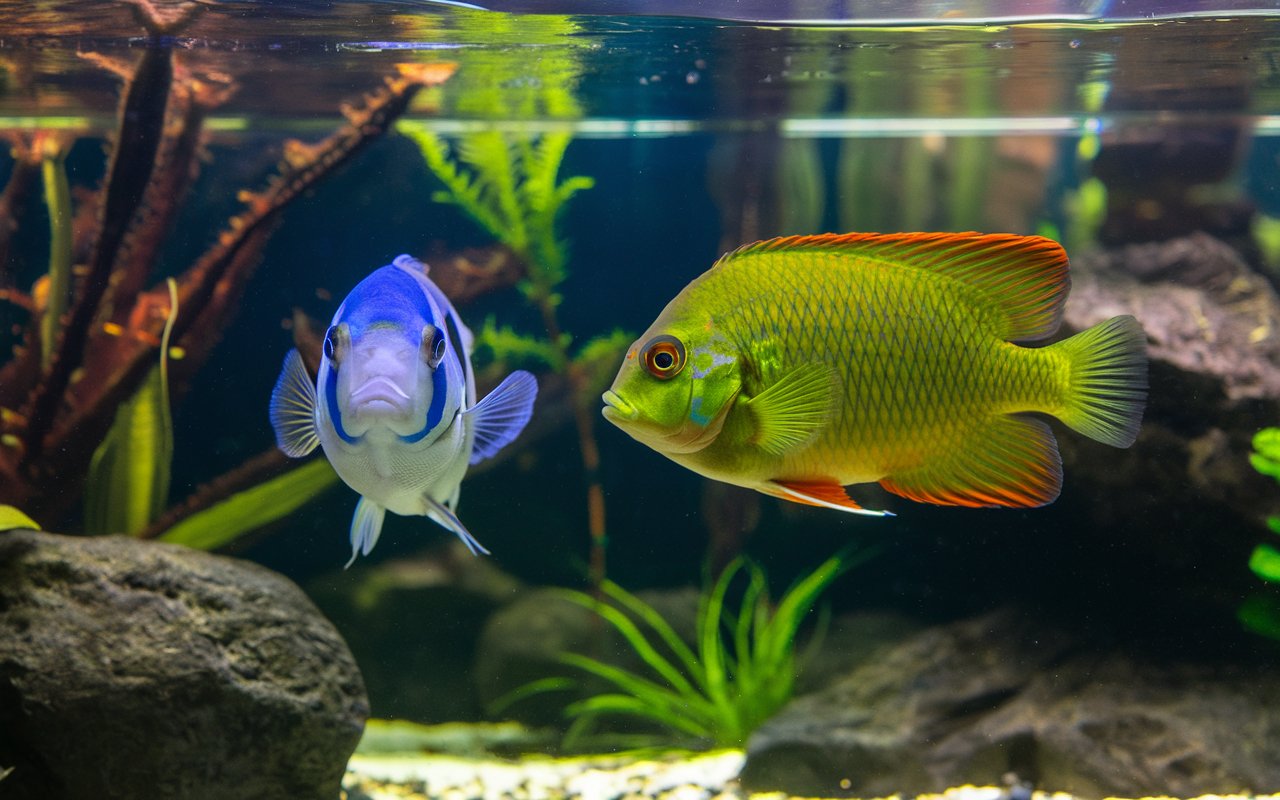The Blue Face Brichardii Fish and the Oscar Fish are two striking species of cichlids that captivate aquarium enthusiasts with their unique appearances and behaviors. The Blue Face Brichardii, known for its vibrant blue facial markings and intricate social structure, originates from Lake Tanganyika in East Africa. In contrast, the Oscar Fish, with its diverse color patterns and interactive nature, hails from the Amazon Basin in South America. Both species require specific care to thrive in captivity, including appropriate tank setups and diet. This guide delves into the key aspects of maintaining these beautiful fish, comparing their needs and behaviors to help you create an optimal environment for both. Whether you’re a seasoned aquarist or a beginner, understanding these cichlids will enhance your aquarium experience.
Appearance and Characteristics
Coloration:
The Blue Face Brichardii Fish is distinguished by its vibrant blue facial markings and a predominantly silver or white body. This coloration creates a stunning visual contrast that appeals to many fish keepers.
Size:
This medium-sized cichlid typically grows to about 4-5 inches in length, though in optimal conditions, it can reach up to 6 inches.
Behavior:
Known for its territorial nature, the Blue Face Brichardii exhibits complex social behaviors, often forming intricate hierarchies within its environment. In the wild, it’s observed to live in large groups, which is essential for its well-being in captivity.
Habitat and Care Requirements
Tank Setup:
The Blue Face Brichardii thrives in an aquarium that mimics its natural habitat. This includes a well-filtered tank with a rocky substrate and ample hiding places. The tank should be spacious, ideally a minimum of 30 gallons, to accommodate its social structure and territorial nature.
Water Conditions:
Maintaining stable water conditions is crucial. The tank should have a pH range of 8.0 to 9.0, a temperature range of 74°F to 78°F, and moderately hard water. Regular water changes and a quality filtration system are essential to keep the environment healthy.
Diet:
In captivity, the Blue Face Brichardii Fish requires a diet rich in protein. High-quality cichlid pellets, live or frozen foods such as brine shrimp and bloodworms, are ideal for maintaining its health and vibrant coloration.
Exploring the Oscar Fish
The Oscar Fish, scientifically known as Astronotus ocellatus, is another popular cichlid species, famous for its striking appearance and interactive behavior. Native to South America, this fish is often found in the rivers and lakes of the Amazon Basin.
Appearance and Characteristics
Coloration:
Oscars are known for their diverse color patterns, which can include shades of red, orange, yellow, and black. Their appearance can vary significantly depending on their morph and age.
Size:
Oscars are large cichlids, with adults typically reaching 12-18 inches in length. They require ample space to thrive, making them suitable for larger aquariums.
Behavior:
Oscars are known for their intelligence and interactive behavior. They can recognize their owners and often display unique personality traits, such as playful interactions with their keepers.
Habitat and Care Requirements
Tank Setup:
Given their size, Oscars require a large aquarium, with a minimum recommended size of 75 gallons. The tank should include hiding spots and a strong filtration system to handle their substantial waste production.
Water Conditions:
Oscars prefer a water temperature range of 74°F to 80°F and a pH level between 6.0 and 8.0. Regular water changes and a robust filtration system are necessary to maintain water quality.
Diet:
Oscars are omnivorous and thrive on a varied diet. High-quality pellets, live or frozen foods, and occasional vegetable matter should be included in their diet to ensure balanced nutrition.
Comparing Blue Face Brichardii Fish and Oscar Fish
While both the Blue Face Brichardii Fish and the Oscar Fish are popular among aquarium enthusiasts, they have distinct differences:
Size and Space:
Oscars require significantly more space due to their larger size compared to the Blue Face Brichardii Fish. A 75-gallon tank is ideal for Oscars, while a 30-gallon tank can suffice for Blue Face Brichardii.
Behavior and Social Structure:
The Blue Face Brichardii Fish is more territorial and social, often thriving in groups. In contrast, Oscars are more solitary and can become aggressive, particularly towards other fish of similar size.
Care Requirements:
Both species need stable water conditions and a high-quality diet, but the Oscar Fish demands more frequent water changes due to its larger size and higher waste production.
Unique Care Tips for Each Species
- For Blue Face Brichardii Fish: Ensure a tank with plenty of hiding spots and simulate their natural environment as closely as possible. Monitor their behavior to prevent territorial disputes.
- For Oscar Fish: Provide a larger tank with ample space for swimming. Be prepared for their aggressive behavior and ensure compatibility with other tank mates.
FAQs
1. What is the ideal tank size for Blue Face Brichardii Fish?
A minimum of 30 gallons is recommended, with more space if keeping multiple fish.
2. How often should I change the water for Oscar Fish?
Regular water changes of 20-30% weekly is recommended to maintain water quality.
3. Can Blue Face Brichardii Fish live with other species?
Yes, but they can be territorial. Choose tank mates that are not overly aggressive.
4. What temperature is best for Oscar Fish?
A temperature range of 74°F to 80°F is ideal for Oscars.
5. How can I tell if my Blue Face Brichardii Fish is stressed?
Look for signs such as hiding, aggression, or changes in coloration.
6. Do Oscar Fish need special lighting?
While Oscars do not require special lighting, a standard aquarium light can help showcase their colors.
7. What are the common diseases affecting Blue Face Brichardii Fish?
Common issues include ich, fin rot, and external parasites. Regular monitoring and good water quality can help prevent these.
8. Can Oscar Fish eat live food?
Yes, Oscars can eat live food such as feeder fish, but it should be offered in moderation.
9. How long do Blue Face Brichardii Fish live?
They typically live around 5-7 years in captivity with proper care.
10. What type of substrate is best for Oscar Fish?
Oscars prefer a substrate of fine gravel or sand, which is easier on their sensitive barbels and helps with waste management.
Conclusion
Both the Blue Face Brichardii Fish and the Oscar Fish offer unique and rewarding experiences for aquarium enthusiasts. The Blue Face Brichardii’s vibrant colors and social behaviors make it a fascinating addition to a well-maintained tank, while the Oscar Fish’s intelligence and striking patterns bring dynamic energy to a larger setup. By understanding their specific care requirements and behaviors, you can ensure a healthy and thriving environment for these stunning cichlids. Proper tank conditions, diet, and regular maintenance are key to their well-being. Embracing the challenges and joys of caring for these fish will enrich your aquarium experience and showcase their remarkable beauty.





